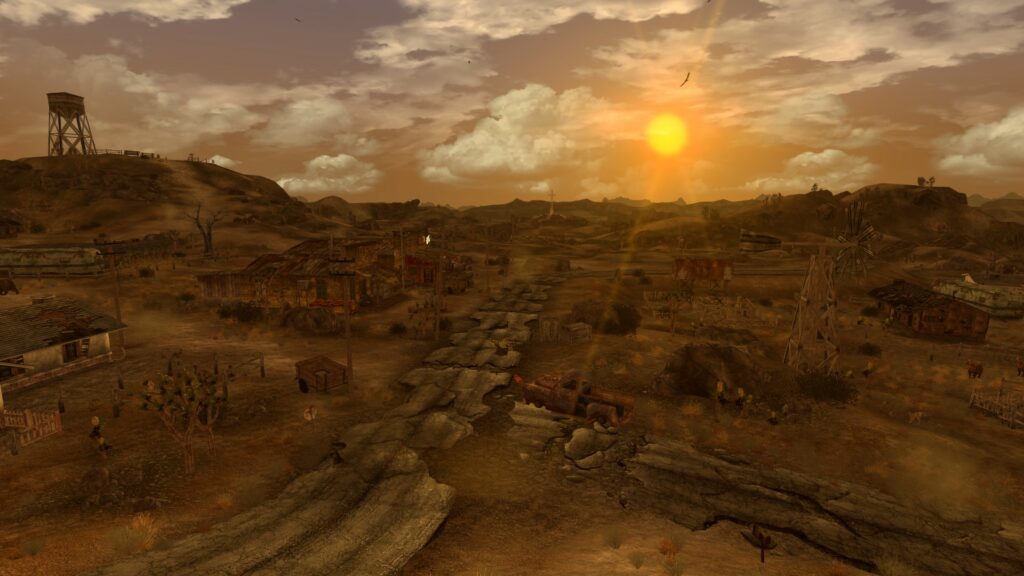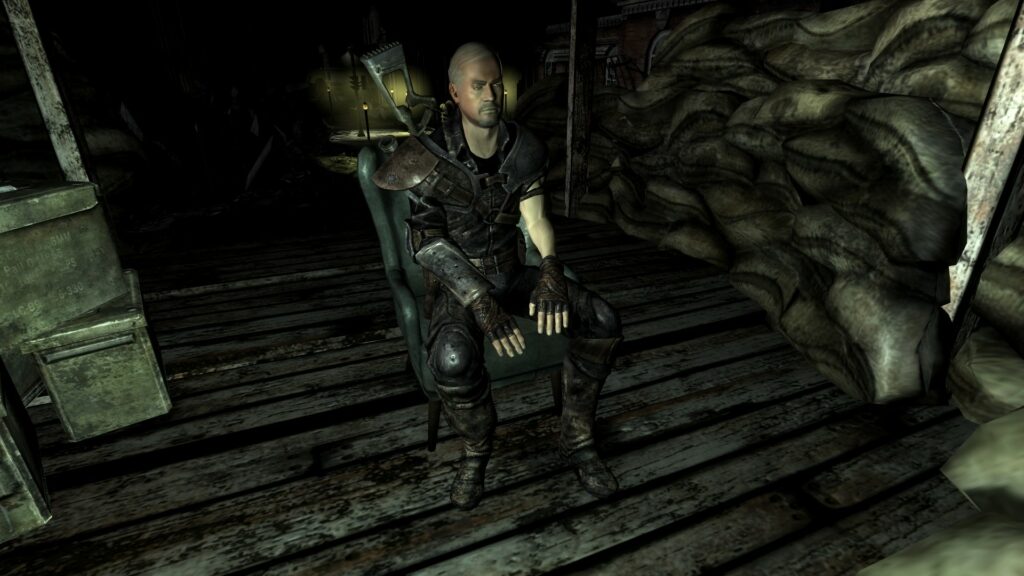
Before we start in earnest, I should mention that it’s easy to be an armchair critic. It’s a lot harder to actually implement something if you’re the one who has to do it. On the other hand, I’m an experienced author (I have a dozen+ novels published under several pen names, though nothing under this one… yet) and most of what I’ll be talking about is really basic stuff any decent writer should be thinking about before they even put pen to paper, or fingers to keyboard.
World building, tone, logic, internal consistency, pacing, all of these are important to crafting a believable world and story. Unfortunately, Bethesda failed on nearly every count, with the main exceptions being atmosphere and the transition from isometric to 3D, which I mentioned in the introduction.
Still, while I acknowledge that being an armchair critic is easier than actually being the one to fix the problems, it’s also true that improvements can only be made when you look at what went wrong and propose solutions, so that’s what I’ll be doing here.
Plus, most of what I’ll be suggesting wouldn’t even take that much additional effort over what was already implemented. It’s more about tweaking the existing world to make more sense. Frankly, this is the sort of thing a creative director should be keeping an eye on, but apparently Bethesda doesn’t employ one of those.
Todd Howard seems to take a very hands-off approach to game design, and apparently lets people do pretty much whatever they like (though he clearly has final say on anything new someone wants to add, based on various interviews). That’s a great way to get lots of creative ideas flowing, but it’s also an excellent way to end up with an unfocused, incoherent mess of a game.
New Vegas, on the other hand, did have a creative director, and it shows in how well that game’s world holds together under scrutiny. All right, enough rambling let’s get this show on the road. Strap in and a grab some snacks and a Nuka-Cola. Or Sunset Sarsaparilla, if you prefer.

To kick off, allow me to indulge in an example of how I feel an RPG—or at least, a western RPG such as Fallout—should be handled: New Vegas! Didn’t see that one coming, did you? In my opinion, the very best aspect to this game is that it provides numerous interesting and often non-violent ways to overcome challenges and complete quests.
The game is so well-designed that it’s entirely possible to do kill everything and no kill runs, plus everything in-between. For example, Youtuber Many A True Nerd once did a special episode where he had to complete the game in Hardcore mode without eating or drinking, effectively turning it into a speed run. (Note, I grew tired of MATN’s content years ago, but his Kill Everything and You Only Live Once Fallout runs are still worth as watch.)
More than that, you can actually role-play (imagine that!). If you want to roleplay a sleazy, underhanded snake oil salesman hell-bent on profit, profit, profit, you can. If you’d like to play a crazed maniac, you can. A pacifist? Check. A smooth-talking gunslinger with a penchant for larceny? Knock yourself out! The setting and gameplay systems work together to allow this.
Conversely, Fallout 3 does more or less none of that, instead opting for The Bethesda Approach™ of haphazardly dumping Rule of Cool locations down in a theme park style where nothing is coherent, nothing makes sense or connects to anything else in the world, and there are generally only very limited ways to complete quests. And shooting someone in the face almost always takes precedence. But only when the game tells you that you can, because before that point you’ll probably have to deal with the essential tag.
Most of the stats from the original games were carried across, which actually surprises me, but I suppose Bethesda hadn’t gone through their Skyrim streamlining process at that point. Some of these stats are occasionally used in dialogue in Fallout 3, true, but very few compared to New Vegas, and with a few exceptions most quests lack many alternate options for completion.
This illustrates the general difference in approaches by Bethesda and Obsidian. Bethesda are more concerned with player power fantasy, letting them feel like the centre of the universe, like they’re the most powerful being alive, the chosen one, to use the common trope which nicely describes most of their player avatars for the last two decades. Their worlds also reflect this in their ‘pick any direction and walk’ exploration philosophy.
Conversely, Obsidian focuses on world, story, and choice—including the consequences for those choices—by providing a blank slate for the player to inhabit and letting them decide the type of person they wish to be in this world. The world of New Vegas also reflects this, by gently funnelling the player in a horseshoe-shaped route that gives them an optimal experience. We’ll talk more about that later.
A person is defined by their words and actions, not some arbitrary fact of birth, and role-playing games should be much the same. Unfortunately, Bethesda normally bases the player character on circumstances outside their control, with the Dragonborn being perhaps the most egregious example.
To quote Chris Avellone:
“The biggest lesson [learned from Fallout 2] was if you give the player the ability to create a certain type of character, make sure that you honour the player’s character build. What I mean by that is if you give a character to option to dump 500 points into speech, make sure they have an experience that’s very cool and is appropriate for a speech based character. The same thing is true if you’re a stupid combat monster, if you’re a sneaky thief who no one ever sees. If you’re allowing the players to build a character like that with the rule set, then make sure your content supports that experience.”
Does Fallout: New Vegas succeed in this? Hell, yes. Does Fallout 3? Hell, no. Though to be fair, it succeeds far more than Fallout 4 does. So why is that? I think at least part of the reason is trust. Bethesda have this world they want to show the player, and a story—however nonsensical—they want to tell, and they don’t trust the player not to break it by trying to do things outside the scope of what they planned for.
There’s also a degree of laziness there, as exemplified by a fairly recent statement Todd Howard made on why they don’t want to create a new engine: because it’s easier to continue using the one they’re familiar with.
“We like our editor. It allows us to create worlds really fast and the modders know it really well. There are some elementary ways we create our games and that will continue because that lets us be efficient and we think it works best,” Howard explains.
Todd Howard
And if you think all of this sounds silly coming from a developer that goes out of its way to market their games as being totally open ‘do anything you like’ adventures… you’d be right, it is silly. The really ironic thing? Todd Howard actually stood up on a stage and spouted this line:
“In a game like Skyrim or Fallout 3 we give the player a lot of credit. We trust him. He is the director of his experience.”
Yes, because railroaded experiences where you can’t deviate from the path set out for you, or choose to be anything other than what Bethesda wants you to be shows trust in the player.
(Note: I don’t know exactly when or where he said this, maybe a developer conference kind of deal. I’ve seen the video itself, but it was integrated as part of someone else’s critique of Bethesda / their games that I watched once.)
You’re forced to side with the Brotherhood of Steel if you want to complete the game, regardless of whether you’re attempting to play a good or bad character, or whether you’d rather just help another faction… if any others existed for you to help. Feeling like a director of your own experience yet?
Obsidian, on the other hand, does trust the player, by allowing them the freedom to tackle quests in a variety of ways, but most importantly by letting them kill everything. They understand that some players will want to play this type of character.
For example, a psycho who simply gets off on killing; a mentally unstable ex-military guy who finally snapped; an animal-lover who couldn’t harm a cute and cuddly Radscorpion to save her life, but will kill every single human she comes across. And so on. By letting the player express themselves like this, by constructing the world in such a way that they can kill everything, Obsidian shows a level of trust in the player that Bethesda can’t seem to wrap their collective heads around (Morrowind excepted, but Bethesda was a different studio back then).
Of course, this doesn’t mean you should go around killing everyone, but the option exists because that’s what a good role-playing game should support; choices, and the consequences that flow from them.

Let’s take a quick look at Fallout 3 in this context. Say you want to create a speech build, some kind of ultra-reserved pacifist who prefers to deal with things non-violently through dialogue and creative problem solving. Can you do this? No. Because there are so few real speech options in Fallout 3 that it makes the speech stat pretty useless.
Not to mention that the random percentage-based chance reduces it to a game of save-scumming rather than role-playing, a problem exacerbated even further in Fallout 4 where you can quick-save during dialogue. Likewise, there are very few alternate paths to completing quests, making speech largely pointless. Though again, it’s still better than what they pulled in Fallout 4… jeez, I’m actually defending Fallout 3 because their follow-up game is that much worse.
Similarly, if you wanted to create a nihilistic build—like the above ones that you could create in New Vegas—where your character basically just wants to shoot everyone in the face, you can’t even do that in Fallout 3, despite the heavy emphasis on combat, because it breaks Bethesda’s railroading.
For example, a kill everything run is technically impossible because so many characters in Fallout 3 have the essential tag set on them. Many a True Nerd managed it, and did a fantastic job of creating a kill everything run that was immense fun to watch, and he often used the essential tag spam for extra hilarity, so props to him for that. It doesn’t change the fact that essential tag spam is just lazy game design, however. Not only does this lazy design break immersion, it severely limits player agency; having everyone be absolutely fine with you after a few in-game days even if you just attempted to murder half the town is one of the most jarring immersion breakers imaginable.

Now take the main story, such as it is. You’re expected to help the White Knighthood against the Super Mutants and, later, the Enclave. You don’t get a say in this, you can’t choose sides, and there’s nothing you can do to influence outcomes. It all boils down to ‘Bethesda says these are the good guys, those are the bad guys, and you WILL support the good guys’.
Which leads to the hilarious situation of being able to run around the Citadel killing all the Brotherhood members—most of whom get back up five seconds later, thanks to the essential tag—and still fight alongside them. Try that in New Vegas and you’d be shot on sight.
Another amusing problem is that Liberty Prime’s movement is tied to one of the Brotherhood members… who doesn’t have the essential tag, meaning you can actually break the final mission of the game by killing that one untagged character. That happened to Many A True Nerd during his Fallout 3 kill everything series.
See, this is what happens when you spam a tag to make NPCs immortal in order to stop the player from breaking your precious story… but then forget to tag an actually essential character while simultaneously being too lazy to think up alternate routes for the player to take. You get a broken game and the player has to figure out a way to fix it.
Compare this to Fallout: New Vegas’s approach. You have total freedom to kill everyone—with two exceptions: Yes Man and the Vendortron—you can talk your way out of most major battles or situations (Ulysses, for example, or even the Legate, harkening back to Fallout 1’s encounter with the Master, though it’s admittedly nowhere near as interesting or involved), and there are bountiful checks against various SPECIAL stats and skills (Speech, Barter, Sneak, etc.) with a great many alternate ways to complete quests.
In Part 2, I’ll talk about some of the actual locations in the wasteland. At length.
If you enjoy my work, consider buying me a coffee, or jump onto my newsletter to receive updates, free chapters, stories, and other goodies.


